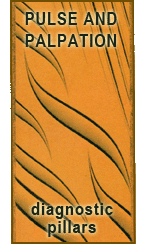The Thin Pulse (Xi Mai)

Thin Pulse (?? Xi Mai)
key point: thin
Indications: qi deficiency is unable to command the blood hence, it doesn’t fill the vessels.
Yin or blood deficiency: substance is too deficient to fill the vessel.
Dampness: accumulates around vessel, compressing its width (can be deep for same reason).
Explanation: in the graphic that came up earlier, we showed how a lack of fluids such as yin or blood can generate the thin pulse. That’s kind of a no-brainer. However, should you run in to a thin pulse in a patient who shows only signs of qi deficiency, it is okay to say that the qi isn’t strong enough to push the blood such that the vessels are not adequately dilated as the pulse wave passes by, hence the thin (and likely forceless) pulse.
One more reason for a thin pulse may have to do with excessive adipose tissue (“phlegm damp accumulation“) located in the wrist. If you’re palpating the pulse in an obese patient, the adipose tissue may accumulate around the vessel, compressing its width and giving rise to a thin pulse.
Alism: Just between you and I, these adipose laden wrists also generate submerged pulses without necessarily those patterns described by the submerged pulse. That point doesn’t really show up on any Chinese textbooks that I know of. It’s just something that one notices among a patient population that may be overweight. Welcome to America.

The Thin Pulse

How can you tell if a thin pulse is due to deficiency or excess? Don't ignore the obvious!
Learning signs and symptoms as intellectual facts is not as accurate diagnostically or therapeutically as understanding the whole person’s context for any medical intervention. You can’t simply note the signs and symptoms of the patient while ignoring the larger constitutional backdrop. In other words, don’t ignore the obvious.
Next: you don’t need a sponge, even if the pulse is soggy.
 Last modified: July 28, 2009
Last modified: July 28, 2009  Tags: Diagnosis, Palpation · Posted in: Pulse Class, Pulse-Palpation
Tags: Diagnosis, Palpation · Posted in: Pulse Class, Pulse-Palpation
